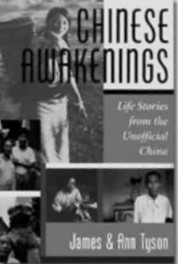
Chinese Awakenings by James and Ann Tyson. Westview Press, 1995, 325 pp. ISBN, 0813324734, paperback. Cost: $28 at www.barnesandnoble.com.
The plaudits on the back cover lured me into this book, and they served to express my reaction when I finished the last of its 325 pages:
“A superb inside view of China to the grass roots level… These Chinese lives as told by the Tysons are touching, but they ring true…” – Ezra Vogel, Harvard University.
“One of the most illuminating books on the profound changes affecting 1.2 billion Chinese as a result of the Deng Xiaoping reforms. This is the most penetrating analysis of how the reforms have affected various sec- tors of Chinese society that I have read. An eye- opening, and often chilling, account.” –David Shambaugh, Editor of The China Quarterly.
In contrast to the equally impressive China Wakes by another husband and wife team, Nicholas Kristof and Sheryl WuDunn, this book takes a vertical slice out of different subgroups of China’s population by following the lives of nine different people and their families. By tracing their careers over several decades, the authors expose us to the vicissitudes of China’s tumultuous history since the Communist victory in 1949.
For insight into the rapidly changing China of the early 1990s, Chinese Awakenings provides an excellent companion volume to China Wakes. The Tysons have also filled out the portrait of the Communist years that we find in such accounts as Wild Swans, Life and Death in Shanghai, and China: Alive in the Bitter Sea.
First, they look at the liberation from the drudgery of farm life of a woman who migrated to a city to find work. Then, they describe the amazing rise of Zhang Guoxi to become one of China’s richest men presiding over an empire built totally from his own entrepreneurial skills. Next, they turn to the torturous experiences of a man whom they call “the Shanghai cosmopolite.”
They go to the far west to see how Tibetan nomads have fared under the rule of Han Chinese Communists, then to the southeast to report on the resurgence of clans. Both these sketches show the tenacity of traditional customs, including religion, despite communist propaganda and pressure.
Part Three paints the dark side of the recent reforms: at “the bold feast,” people like the women left behind on the farms and the countless industrial workers “starve.” While their husbands have found new prosperity in the cities, the wives of millions of farmers are left to do all the work in the fields.
Meanwhile, workers languish under harsh conditions in a new system of raw and unrestrained robber-baron capitalism. Exploitation of women and workers, which communism was sup- posed to eradicate, lives on with even greater intensity than before.
Part Four looks at two Chinese who have challenged the state: a journalist turned dissident and a student turned collaborator. Each one started out with high, almost idolatrous, expectations—even worship—towards Mao and his radical revolution. Each one was horribly disillusioned. One continues to speak and write, albeit from the safety of the United States. The other keeps quiet, nursing hopes for eventual reform and biding his time.
The major thesis of the Tysons seems persuasive: millions of Chinese are carving out a new life for themselves either in total neglect of the policies, propaganda and programs of the Communist Party, or in some sort of manipulative relationship with it. Each chapter shows how the Party has lost credibility among the masses it was supposed to represent. Hardly anyone believes the rhetoric emanating from official organs anymore. Instead, the Party is seen as a self-perpetuating organization of power-hungry, corrupt and utterly ruthless bureaucrats.
The Tysons fill their carefully researched book with dozens of examples of Communist Party corruption and oppression. They explain why countless Chinese have replaced their earlier enthusiasm for the Communists with bitter disillusionment, even outrage and hatred. No wonder the authorities in Beijing feel they must impose rigid, even ruthless controls, on all dissent! With so much simmering anger against them, the Party bosses must find ways to distract, divide and discourage anyone seeking political reform lest a popular movement sweep them from power.
Indeed, the Tysons seem to think that the tide of history is with those who desire a more open and free society. They do not predict an immediate change of regime, however, since the Party has total control and the will to use it. Nor, do they think that students and other reform-minded activists have the mental framework yet or the personal maturity to replace the current government with anything better. It will take years for the Chinese to build a basis of political theory and social sophistication in order to bring into being a truly representative and free governmental system.
Nevertheless, the authors do see change coming from the grass roots, a change that will ultimately weaken and perhaps even destroy the stranglehold that the Party now has on real political power. Too many people are now making choices and building lives independently of Party control. There are so many nongovernmental organizations and enterprises that the government cannot keep a lid on the forces of transformation that will work themselves up from below.
One final observation: for those living in America, who have never experienced the kind of suffering and repression that hundreds of millions of Chinese have endured for many decades, just reading the stories of the nine people featured in this volume will inject a much needed sobriety into our thoughts about life. We have had it easy! Our hearts and our admiration go out to those who have survived “life in the bitter sea.”
John Peace
John Peace, Ph.D., is a pen name for a scholar who has worked among Chinese in Asia and America for 25 years.View Full Bio